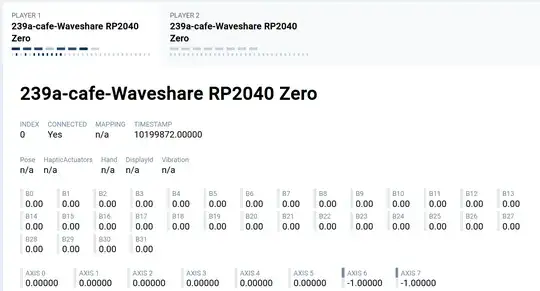By selecting the Adafruit TinyUSB USB stack option (Tools->USB Stack->Adafruit TinyUSB) of the arduino-pico core instead of the default (Pico SDK) the USB HID descriptors can be configured directly to expose two HID gamepads.
The disadvantage of this approach is that the easy to use preconfigured devices (e.g. Joystick, Mouse and Keyboard) are not configured, but this gives you the option to use the full flexibility of TinyUSB to configure USB devices. While I've used it with my Waveshare Pi Pico Zero board it should work with any Arduino board that Adafruit TinyUSB supports.
Here is a test sketch that sets up a HID device with two gamepads similar to the "Hey how about two players?" example in https://eleccelerator.com/tutorial-about-usb-hid-report-descriptors/. I modified the Adafruit TinyUSB hid_gamepad.ino example by adding a second Gamepad report and shortening the "demo" loop to save space:
/*********************************************************************
Adafruit invests time and resources providing this open source code,
please support Adafruit and open-source hardware by purchasing
products from Adafruit!
MIT license, check LICENSE for more information
Copyright (c) 2021 NeKuNeKo for Adafruit Industries
All text above, and the splash screen below must be included in
any redistribution
*********************************************************************/
#include "Adafruit_TinyUSB.h"
// NB NB!!! Select "Adafruit TinyUSB" for USB stack
// HID report descriptor using TinyUSB's template
uint8_t const desc_hid_report[] =
{
TUD_HID_REPORT_DESC_GAMEPAD(HID_REPORT_ID(1)), // First gamepad report-id 1
TUD_HID_REPORT_DESC_GAMEPAD(HID_REPORT_ID(2)) // Second gamepad report-id 2
};
// USB HID object. For ESP32 these values cannot be changed after this declaration
// desc report, desc len, protocol, interval, use out endpoint
Adafruit_USBD_HID usb_hid(desc_hid_report, sizeof(desc_hid_report), HID_ITF_PROTOCOL_NONE, 2, false);
// Report payload defined in src/class/hid/hid.h
// - For Gamepad Button Bit Mask see hid_gamepad_button_bm_t
// - For Gamepad Hat Bit Mask see hid_gamepad_hat_t
hid_gamepad_report_t gp[2]; // Two gamepad descriptors
void setup()
{
#if defined(ARDUINO_ARCH_MBED) && defined(ARDUINO_ARCH_RP2040)
// Manual begin() is required on core without built-in support for TinyUSB such as mbed rp2040
TinyUSB_Device_Init(0);
#endif
Serial.begin(115200);
usb_hid.begin();
// wait until device mounted
while( !TinyUSBDevice.mounted() ) delay(1);
Serial.println("Adafruit TinyUSB HID multi-gamepad example");
}
uint8_t gp_i = 0;
void loop()
{
if ( !usb_hid.ready() ) return;
Serial.print("Testing gamepad nr: ");
Serial.println(gp_i);
// Reset buttons
Serial.println("No pressing buttons");
gp[gp_i].x = 0;
gp[gp_i].y = 0;
gp[gp_i].z = 0;
gp[gp_i].rz = 0;
gp[gp_i].rx = 0;
gp[gp_i].ry = 0;
gp[gp_i].hat = 0;
gp[gp_i].buttons = 0;
// gp_i + 1 is the HID report-id, i.e. 1 for first gamepad and 2 for the
// second, as defined in desc_hid_report[] above.
usb_hid.sendReport(gp_i + 1, &gp[gp_i], sizeof(gp[gp_i]));
delay(2000);
// Random touch
Serial.println("Random touch");
gp[gp_i].x = random(-127, 128);
gp[gp_i].y = random(-127, 128);
gp[gp_i].z = random(-127, 128);
gp[gp_i].rz = random(-127, 128);
gp[gp_i].rx = random(-127, 128);
gp[gp_i].ry = random(-127, 128);
gp[gp_i].hat = random(0, 9);
gp[gp_i].buttons = random(0, 0xffff);
usb_hid.sendReport(gp_i + 1, &gp[gp_i], sizeof(gp[gp_i]));
delay(2000);
// select the other gamepad
gp_i = (gp_i + 1) % 2;
}
Linux HID Malarkey
For some reason the Linux kernel by default ignores multiple reports of the same type of HID device. I.e. a device with a mouse, keyboard and joystick device reports are no problem, but if a device has multiple of the same HID reports, say, two gamepads, Linux will only see the first instance. To enable multiple instances the HID_QUIRK_MULTI_INPUT setting must be enabled for the specific USB device.
These instructions worked on Ubuntu 22.04, you may need to adjust them for your distro.
After programming the example sketch I could see the ID of my Pi Pico USB device with `lsusb:
$ lsusb
...
Bus 001 Device 011: ID 239a:cafe Adafruit RP2040 Zero
...
Note down the USB device identifier (239a:cafe) and create a file in /etc/modprobe.d to configure the usbhid module:
$ echo "options usbhid quirks=0x239a:0xcafe:0x040" | sudo tee /etc/modprobe.d/adafruit_hid_quirk.conf
$ sudo update-initramfs -u
Requires a reboot to take effect, e.g.:
$ sudo shutdown -r now
The 0x239a:0xcafe is from the lsusb output and 0x040 is the magic number to enable HID_QUIRK_MULTI_INPUT mode. We need update-initramfs since usbhid is usually loaded too early in the boot process for the settings from /etc/modprobe.d to take effect without it being in the initrd.
Once you have rebooted you can check if the usbhid setting took effect:
$ cat /sys/module/usbhid/parameters/quirks
0x239a:0xcafe:0x040,(null),(null),(null)
and you should see two joystick devices after programming the sketch:
ls /dev/input/js*
/dev/input/js0 /dev/input/js1
Testing
An easy way to test is to navigate to https://gamepad-tester.com/. After a short period you should see something like:

You should see Player1's values toggle and then Player2's values until you unplug your pico.
